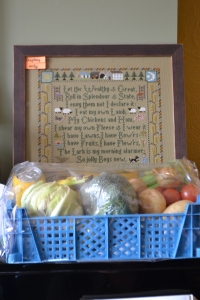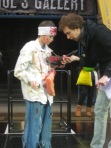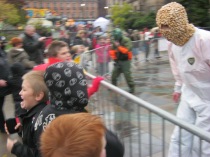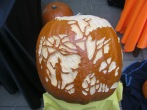On a bright sunny day you could be hard pressed to find a more uplifting location for a custom then on the slopes of Kinder especially for a custom which takes the word lifting quite literally – lifting a barrel up the hill.
Roll out the barrels
Like all good contrived custom, the Beer barrel challenge has the feel of an older traditional custom. The organisers website records:
“The Great Kinder Beer Barrel Challenge has its roots in a bet that occurred in 1998. The original challenge was laid down one bleak January night when local Edale shepherd Geoff Townsend complained to the landlord at the Old Nags Head Inn that they had run out of his favourite beer. Geoff jokingly offered to fetch a barrel of the brew from the Snake Pass Inn, only three miles away as the crow flies, but with 900ft of ascent and descent in between. The landlord agreed that if Geoff succeeded, he could have the barrel (and, more importantly, its contents). So the thirsty shepherd gathered twelve locals to help carry the barrel on a borrowed Mountain Rescue stretcher. He won the bet, shared the beer with his team, and raised £1200 for Edale School in the process.
Following Geoff Townsend’s triumphant effort in, an inventive local Clive Wetherall suggested they do it all again a year later, but invite other teams to compete. Thus the Great Kinder Beer Barrel Challenge was born.”
And so begun a custom and one that is taken very seriously albeit in a lot of fancy dress.
I turned up early as the contestants were getting ready and working out their strategies. Each team, which was made up of eight runners, had to decide upon how to carry the barrel which despite the name contained water not beer. So there were groups trying out ways to attach the barrel to the two parallel poles of the ladder emulating the mountain rescue stretcher – from hanging it from the ladder to sitting on top of it with varying mount of roping – then raising it to see how comfortable it was and whether as the rules insist that at least two people could be in contact with it at all times – a challenge when one considers the mass which was more than 120lbs and the distance travelled – the majority up hill. Although downhill even more challenging on these slopes. There were plenty of practice with teams practicing and making improvements.
Barrel of laughs
The teams had some imaginative names such as the barrel related The Dreggs or the Barrel of Laughs – not sure the name was necessarily shown in their faces though to the Edale & Glossop Mountain Rescue which one would for all of us would be rather good at climbing the peaks!
The message about the competition indicates the challenge of it:
“The route can be walked or ran. Fancy dress is encouraged. The only stipulation is that competitors wear appropriate footwear (trail shoes or walking boots only) and have some navigation experience. Marshals are placed along the route along with route markers. The route can be walked or ran. Fancy dress is encouraged. The only stipulation is that competitors wear appropriate footwear (trail shoes or walking boots only) and have some navigation experience.
The Barrel Race will start at 10:30 from Newfold Farm Campsite. The route follows 4 miles of trail up onto Kinder. It is a challenging route but it is FUN.”
Bottom of the barrel
Sadly, the original goal, the Snakes Pass Inn had closed since the custom had been established and unlike other pub based custom had not killed it off but in a way has made it in a way better especially for the spectator. One can now watch the teams descend to the peak and descend to the finishing line which could not be done in the original format.
Teams set off in intervals and standing at the slopes above one can watch them speed up and then slow down and realised the challenge of the first slope and the impact of doing it on a sunny day….many already looking rather in need of refreshment ironically not from the considerable volume of water they were carrying.
Many teams use music to motivate them which ranged from Taylor Swift to Heavy rock but sadly no cockney anthem – roll out the barrel. I was surprised at the speed in which they ascended the slope and soon disappeared and appeared to be dots reaching the summit. It did not take long to see the first teams descending and I quickly realised I would need to return to the village to see their triumphant entrance….and soon they did; the first being the Gladioli, all dressed in pink with fake gladioli on the centre of the barrel – I wasn’t sure why and did not ask!
I was amazed by the speed of the teams arriving, perhaps like some sort of motor, the downhill slopes gave them more momentum….a large crowd had assembled to watch and cheer on the teams as they crossed the line and then understandably collapsed on the ground just beside.
The Kinder beer challenge is a classic modern custom – pointless like many, colourful and certainly exciting.






















